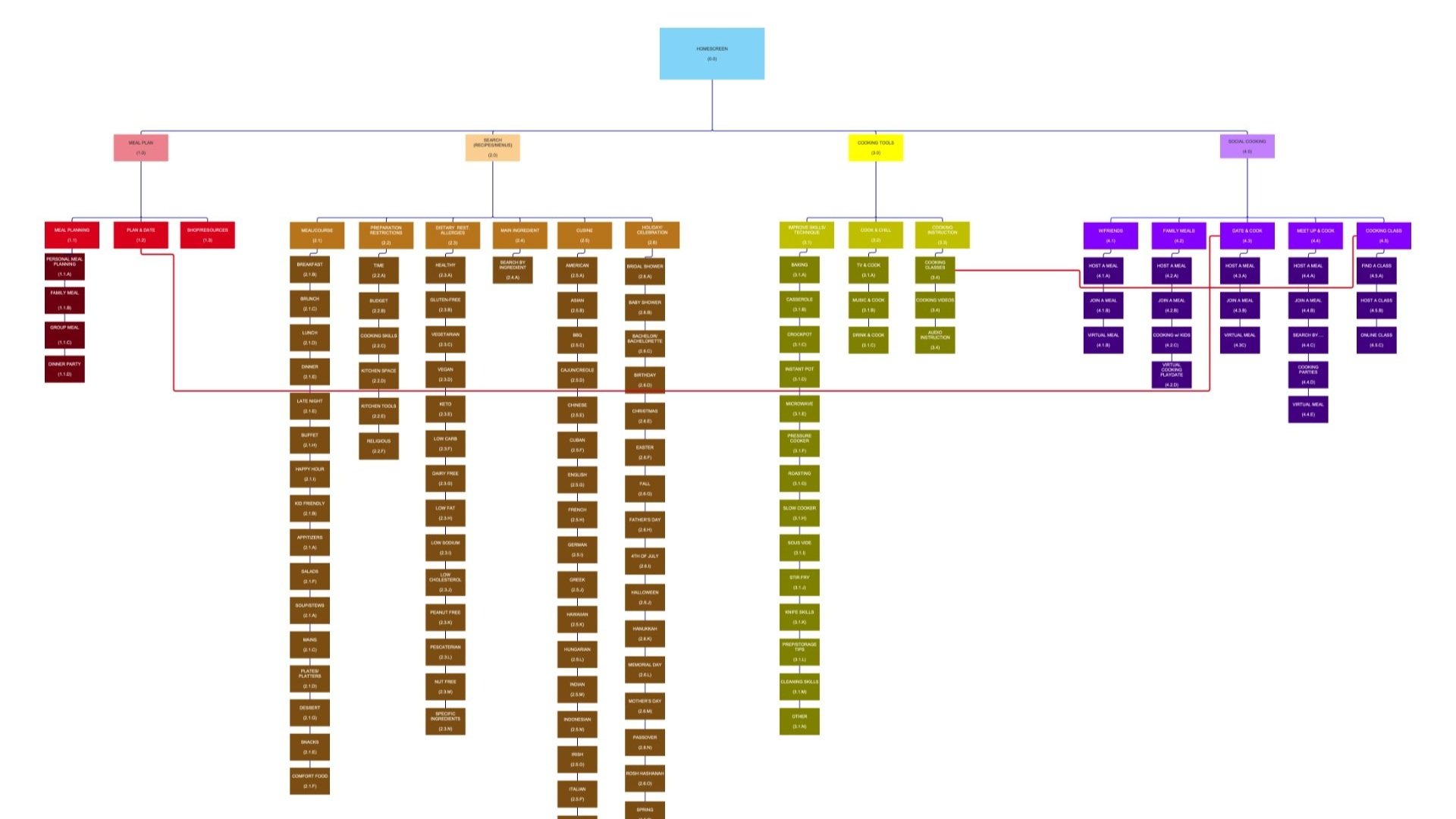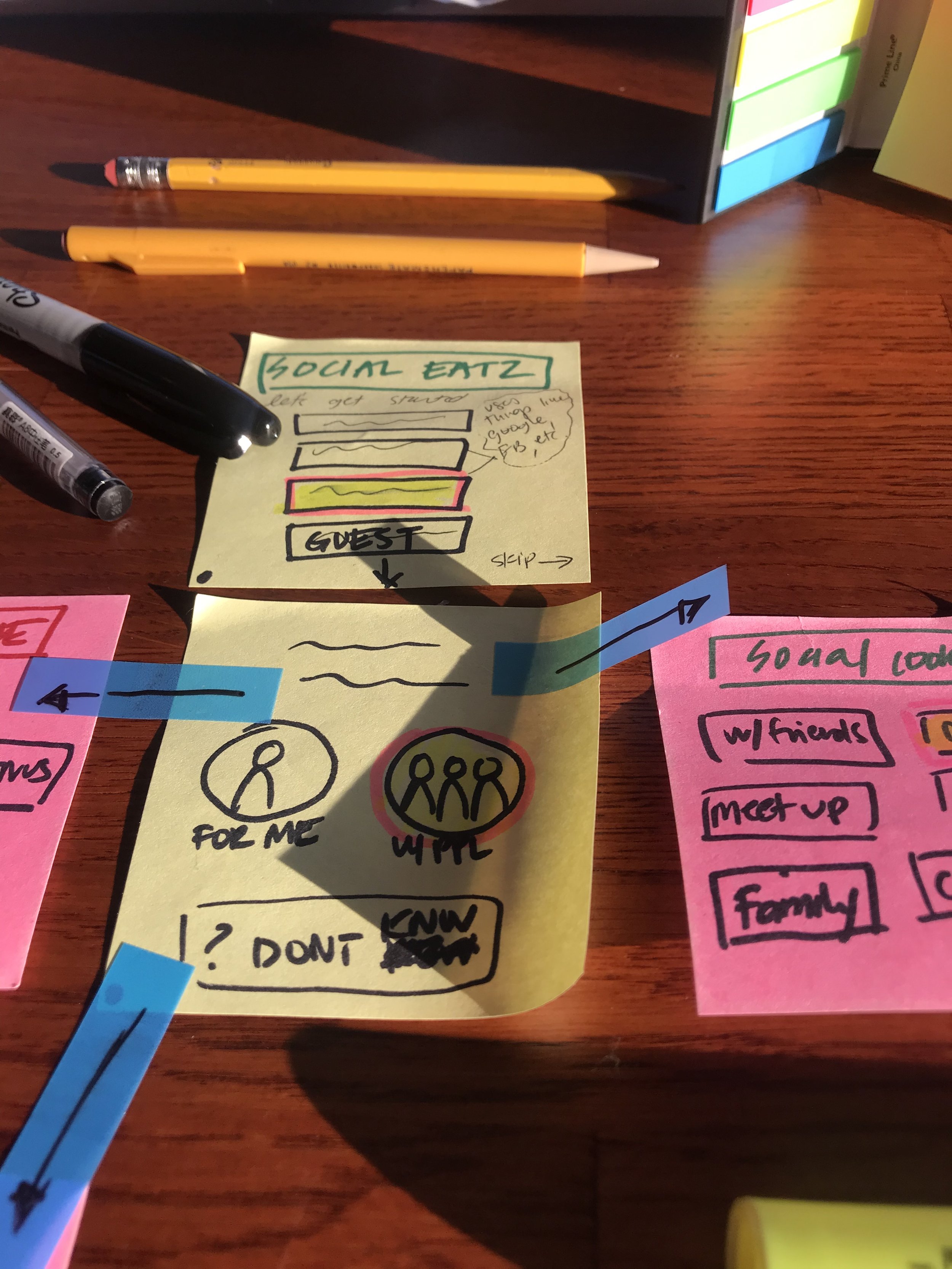
SOCIAL EATZ
Increasing Engagement Through A Social Home Cooking App
CHALLENGE
Create an app experience that increases engagement and retention for busy professionals who don’t cook often.
SOLUTION
A mobile app with personalized features that streamlines meal planning, preparation, and cooking, while integrating social elements to make home cooking a fun, shared experience.
APPROACH
During user interviews, 60% of users (who don’t cook often), said they enjoyed cooking meals most when:
eaten in cozy environments;
music & lighting that provided a relaxing mood;
beautiful plating; and
when shared with someone else.
The approach was to create a social cooking app experience that made users feel connected and relaxed.
BACKGROUND
Since 1995, Epicurious has evolved into the ultimate food resource, expanding to include over 50,000 recipes. In 1998, this brand was the first to pioneer significant traffic growth in online recipe search, and launched its first iPhone app in 2009. In response to shifting user preferences and increased competition, Epicurious sought to revamp its mobile app.
I aimed to enhance user engagement and retention by leading the development of a social-focused mobile cooking app. My team and I crafted an intuitive mobile experience that leveraged design thinking principles, empowering busy professionals to plan, prep, shop, and cook meals seamlessly. Through social feature integration, we enriched user interaction. I oversaw research, strategy, interaction, and visual design components throughout the 8-week speculative project, in my role as lead UX designer.
ROLE
Lead UX Designer: research, strategy, branding, creative direction, light copy, wireframes, high fidelity prototypes, user testing.
CLIENT
Epicurious.com
TOOLS
Google Surveys, Adobe XD, Axure, Keynote, Photoshop, Jira, Miro.
DURATION
10 weeks
Results
INSIGHTS
During user interviews, about 60% of users (who don’t cook often) said they “Enjoyed meals most when eaten in cozy environments, with music & lighting that provided a relaxing mood, beautiful plating, and when shared with someone else.” The approach was to create a social cooking app experience that made users feel connected and relaxed, to make the process more enjoyable.
DESIGN INSPIRATION
The visuals were designed to feel like a candle-lit neighborhood restaurant that allows for organic sharing and connection. Using the design thinking process, high-fidelity prototypes of the app were developed in Adobe XD. Below are some of the key screens showcasing the UX & UI Design.
High-Quality Audio & Visuals
featuring interactive videos, tutorials, photos
Personalized Profile Functions
similar to dating apps, including detailed culinary preferences.
Robust Meal Planning
including calendar features - for organization and meal invitations.
Recipe Search
with customizable preference filters
Streamlined Planning Features
making coordinating social cooking fun and easy.
New Social Features
allow connections based on user interests and backgrounds
DESIGN PROCESS
DESIGN PROCESS
01. RESEARCH
To deeply understand our users’ needs and pain points, extensive market and user research was conducted. Methods included surveys, interviews, and user shadowing. Key research areas focused on current online cooking tools, daily mobile habits, cooking motivations and challenges, and behaviors during meal planning and prepping.
Research Methods
USER SHADOWING
Observed users in their natural environments (markets, homes, work) as they engaged in meal planning and prep, allowing us to witness their behaviors and pain points firsthand.
INTERVIEWS
Conducted in-depth conversations with a diverse group of users to uncover their motivations, challenges, and aspirations related to home cooking. We asked about most used features, favorite functions, ares of improvement, and “wish list” features.
SURVEYS
Distributed to a broad audience to collect quantitative data on user habits and preferences.
Research Focus
USE OF COOKING TOOLS
Explored how users interact with existing tools, identifying what works well and areas that need improvement.
COOKING BEHAVIORS
Closely watched how users plan and prepare meals, noting any inefficiencies or unmet needs.
DAILY MOBILE HABITS
Investigated how users integrate mobile devices into their daily routines, particularly in the context of cooking and meal preparation
MOTIVATIONS & PAIN POINTS
Delved into what drives users to cook at home, as well as the frustrations and obstacles they encounter.
Examples of cooking behaviors
Qualitative user interviews show that,
54% prefer cooking with friends & family, on a date, or on special occasions. This emphasis on the social aspect of cooking suggests that it is seen not just as a necessity, but as a way to build connections and share an experience.
Competitive Analysis
Researched about 20 cooking apps, documenting highly used or unique features and then comparing and contrasting features such as: robust recipe search, meal planning, photo & video tutorials, social features, community features, and customizations.
02. STRATEGY
We synthesized our research findings to define a clear problem statement and create user personas, and user journeys. We focused on the specific needs of single professionals with limited time and ingredients, and examined their pain points and motivations.
User Personas & Journey Maps
To gain a comprehensive insight into our users' goals, needs, experiences, and behaviors, we developed four provisional personas tailored to each user segment. These personas were crafted from user interviews and surveys, and we continuously refined them as more data became available throughout the project. They served as valuable tools that enabled us to step outside our own perspectives and re-evaluate our initial ideas, ensuring our solutions remained aligned with user expectations and requirements.
Jake, Single Professional
Sylvi, Community Focused
Sylvi, Community Focused
Kevyn, In A Relationship
Kevyn, In A Relationship
Keren, Working Parent
Keren, Working Parent
Emotional Journey Map
Challenging User Painpoints
By employing the above research methods, we were able to gain a holistic understanding of our users’ experiences. We further distilled user pain points and motivations of cooking at home using the following tools, and then started to challenge assumptions.
TOOLS
Empathy Mapping
Card Sorting
How Might We (HMW)? Exercise

Challenging The Assumptions
HOW MIGHT WE MAKE COOKING AT HOME…
More social?
More fun & relaxing?
Meet everyone’s dietary restrictions?
Part of building relationships and community?
More fun than eating out?
Less of a time suck?
Help to improve my cooking skills?
Problem Statement
CHALLENGE
Create an app experience that increases engagement and retention for busy professionals who don’t cook often.
POV
A single professional working 40+ hours a week, who comes home with limited time, and specific ingredients available for meal preparation.
HYPOTHESIS
We believe a mobile app with personalized features, that streamline meal planning, preparation, and cooking with available ingredients while integrating social elements; will make home cooking a fun, engaging experience.
03. IDEATE
Using the previous activities & the tools below, the aim was to generate a wide range of ideas that challenged assumptions and brainstormed various creative solutions. The exploration of making home cooking enjoyable and engaging began with a revised hypothesis and defined opportunities.
Ideation Exercises
LIGHTENING DEMOS
A 25-minute sprint on the food app's new features allowed participants to share ideas to enhance user experience. Key discussions included adding sketches of ingredients alongside recipes for clarity and education on fresh produce selection. Another suggestion was interactive elements where users can tap on ingredients to see substitutes and pairings. Additionally, a feature for scanning home ingredients to generate personalized recipe suggestions was proposed. The group also considered a community-driven feature for users to share their ingredient combinations and recipes, fostering collaboration. Overall, the goal was to create a user-friendly experience that inspires users to explore their kitchens confidently.
CRAZY 8’S
The group also used this exercise to sketch out 8 quick ideas on how to generate more app engagement. Some of the concepts included:
Gamification of nutrition and meals
An on-demand “virtual AI” iron chef based on your ingredients
Social Cooking based on lifestyle needs ex: date, community, holiday.
Key Opportunities
-

01. Social Features
Time-constrained individuals are more likely to cook when it involves social interaction, such as cooking for others or sharing cooking tasks. Connect and Cook with friends, family, romantic partners, community, or a class.
-

02. Robust Plan & Search
Users found the robust recipe search features overwhelming. They wanted a simplified system that would allow them to input taste preferences and receive a customized weekly menu based on their nutritional needs, recipe difficulty, available ingredients & tools - all that sync with their calendars.
-

03. Meal Planning
Users desired enhanced meal planning options beyond the current features. They want the ability to use similar ingredients for diverse dishes, a "coach-like" function to monitor calories and macros, high-quality visuals, and possibly interactive features.
-

04. Cooking Tools
Users preferred recipes that use common ingredients and don't require specialized tools, valuing simplicity and practicality. Improving cooking skills, learning something new, and entertaining others were top priorities.

UX SITEMAP
With defined opportunities, key cooking and social functions were identified to best met user needs and preferences. High-level priorities were organized on a site map, providing a framework for the first prototypes.
04. DESIGN
Using the site map, low-fidelity and high-fidelity prototypes of the app were developed. Incorporating easy ingredient-based recipes, and social features designed to enhance user interaction and engagement. Using Adobe XD, Illustrator, and Photoshop, I improved the low-fidelity wireframes by adding a combination of original creative assets and stock photography.

Initial Wireframes + Sketches
With defined opportunities, key cooking and social functions were identified to best met user needs and preferences. High-level priorities were organized on a site map and provided a framework for the first prototypes.
High Fidelity Prototype | Adobe XD
05. TESTING
Low and high-fidelity prototypes were tested with real users. During each testing phase, design flaws, challenges, and necessary changes were noted. After 3 iterations to meet user needs, refinements were added back into the prototype. Designs were updated accordingly.
click to demo XD prototypeIn Conclusion
FINAL APPROACH
Following an algorithm similar to current online dating websites, strong filtering options, and highly customizable profile preferences created well-matched recipes and social connections. In a digital world, we found our app features helped busy professionals spend less time planning, prepping, and organizing. These time-saving steps allowed them to do more cooking, eating, and socializing over food - keeping them more engaged in the process.
FINAL INSIGHTS
The biggest challenge was pivoting the hypothesis to include a wider audience. Though the cooking and meal planning needs were similar across users, there were clear differences in the social needs & functions. Pivoting to define “social” to include cooking with family, community, friends, and potential romantic partners made for a more inclusive experience.













































